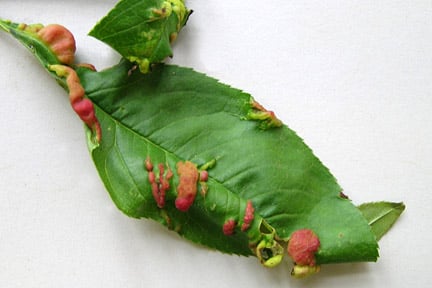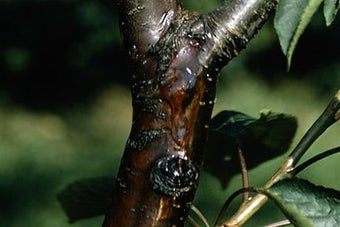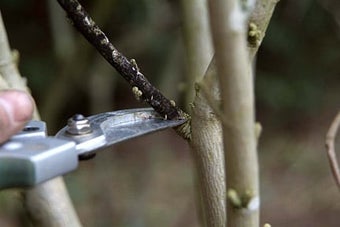
Quick facts
Common name - Peach leaf curl
Scientific name - Taphrina deformans
Plants affected - Peaches, almonds, nectarines and apricots
Main symptoms - Distorted leaves and fungal growth
Caused by - Fungus
Timing - Spring
What is peach leaf curl?
Peach leaf curl is a disease caused by the fungus Taphrina deformans. Infections lead to severe distortion of the leaves soon after leaf burst in spring.
Taphrina deformans infects peaches and nectarines, also almonds and occasionally apricots and ornamental Prunus.
Symptoms
You may see the following symptoms:
- Crumpled, thickened and distorted leaves, often red in colour
- A white bloom of fungal spores on affected leaves
- Diseased leaves fall rapidly, leading to defoliation and loss of vigour
- Shoots and fruits are occasionally attacked
Control
Non-chemical control
Where peaches are grown trained against a fence or wall, a rain shelter of plastic sheeting is very effective at preventing infection. It should cover the top of the tree and the front to within 30cm (1ft) of the ground, but with the ends open to allow access for pollinating insects. It should be erected after leaf fall in November and kept in place until mid-May. Keeping the emerging shoots dry in this way prevents infection and also gives useful frost protection. It is used successfully every year in the Wisley Model Fruit Garden.
A diagram of how to make the lean-to is available as a download below.
Prompt removal of infected leaves before the bloom of white spores appears will help reduce the amount of fungus carried over to the following year.
Some resistance is claimed for the peaches ‘Avalon Pride’, ‘Red Haven’, ‘Harken’, ‘Dixired’, ‘Redwing’, ‘Advance’, ‘Hylands’, ‘Robin Red Breast’ and ‘Rochester’.
Chemical control
There are no fungicides available to amateur gardeners for the control of peach leaf curl.
Lean-to rain shelter diagram (Adobe Acrobat pdf document)

Biology
Some details of the life cycle of this fungus remain unclear. It overwinters within the in a , yeast-like state (feeding very little and on non-living material). As buds break, the fungus penetrates the leaf tissue, causing massive distortion known as hypertrophy (swelling and distortion) without killing the leaf tissues. It then produces a bloom of spores on the infected leaves. These lodge in cracks in the and the buds, forming the overwintering yeast-like state which persists until the next spring.
The tree may produce a second flush of leaves to replace the fallen, infected leaves, but these will not be reinfected by the fungus.
Wet conditions are needed for the spring infections to occur.





